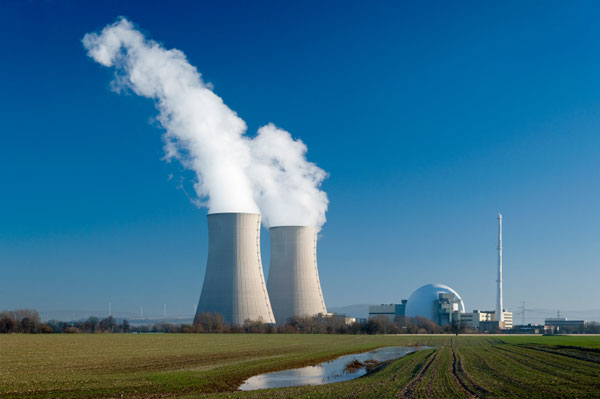Nuclear Power Gets Boost From Top Campaign Cash Recipients
As the House works to set limits on carbon emissions, electric utilities see opportunity.
Jul 31, 202051.7K Shares739.4K Views
As the House works toward a deal setting new limits on carbon emissions, nuclear power is getting a boost from a core group of Democrats – the same lawmakers who have received the bulk of the industry’s campaign donations in recent years.
That electric utilities pushing for nuclear expansion are relying on their longtime congressional champions is not surprising. But the dovetailing of re-election dollars with support for nuclear power masks a more complicated political reality for moderate Democrats, many of whom are shrugging off opposition from environmental groups to embrace the industry as a source of low-carbon energy and a job creator in their districts.
Image by: Matt Mahurin
House Energy and Commerce Committee Chairman Henry Waxman (D-Calif.) and Rep. Ed Markey (D-Mass.), his energy subcommittee chief, are working overtime to reach a deal with centrist colleagues in time to pass their 648-page climate change bill by Memorial Day (1). Adding to that pressure, Roll Call reported this week, are calls from senior Democrats such as Majority Leader Steny Hoyer (D-Md.) and Majority Whip James Clyburn (D-S.C.) to add more benefits for the nuclear industry to the climate measure.
Hoyer and Clyburn ranked No. 3 and No. 5, respectively, among active House members on electric utilities’ list of campaign-money beneficiaries during the 2008 election cycle, according to the Center for Responsive Politics. Since 2003, Hoyer has received $348,800 from the political action committees of electric utilities, compared with $247,500 from investment firms and $133,250 from banks. Clyburn has also received more from electric-utility PACs since 2003 ($183,265) than from banks ($132,800) or investment firms ($102,750).
Another Democrat cited by Roll Call as advocating for more nuclear incentives in the climate bill, House Budget Committee Chairman John Spratt (D-S.C.), has also taken in far more from electric-power PACs than from famously influential banks and investment firms. Electric utilities have contributed $197,900 to Spratt since 2003, while bank PACs have given him just $56,000 and Wall Street PACs $21,000 during that same period.
“The industry can’t build new reactors without unprecedented levels of financial support from the American taxpayer,” Tyson Slocum, the director of Public Citizen’s energy program, said. “When your business model is dependent upon the generosity of the American public in the form of subsidies, they try to accomplish that through giving money to politicians.”
Indeed, the nuclear industry’s biggest players have ramped up their giving to Democrats even further during the first three months of this year. After giving slightly more than half of its donations to Democrats during the 2008 election, the Nuclear Energy Institute PAC sent the majority party more than $56,000 of its $60,000 in first-quarter 2009 campaign donations, according to the Federal Election Commission database.
Duke Energy, which joined NEI as a sponsorof Clyburn’s golf tournament last year, gave $56,000 during the first three months of this year – more than half of what it donated to Democrats during the entire 2008 election season.
“There is no doubt that the tide is moving in favor of nuclear power among Democrats,” Dr. Patrick Moore, the co-founder of Greenpeace turned nuclear advocate at the industry-backed Clean and Safe Energy Coalition, said in an email. Moore said he spoke to the House Nuclear Issues Working Group, which Spratt co-chairs, last week and found a receptive audience.
But not every senior Democrat has benefited from the nuclear industry’s courtship. Waxman has received $27,000 from electric-utility PACs since 2003, with Markey getting a relatively meager $21,000, according to CRP data. House Speaker Nancy Pelosi (D-Calif.), a fundraising powerhouse who has lately softened her criticism of nuclear power, took in only $46,000 from utilities over the past six years.
Are those low fundraising numbers for Waxman, Markey, and Pelosi a smart business decision by nuclear-power companies who want to steer clear of the opposition? Perhaps, Friends of the Earth spokesman Erich Pica said – but it’s also no accident that southeasterners such as Clyburn, Spratt, and Rep. G.K. Butterfield (D-N.C.) form the nuclear industry’s strongest Democratic bloc.
“New nuclear power providers have a foothold in the southeast,” Pica said. “That’s where they’re planning their renaissance. The utilities have captured the public-utility commissions and the state legislatures.”
Both Spratt and Hoyer have large nuclear plants in their districts, with operators looking to build new reactors in the coming years. Nuclear energy generates 20 percent of U.S. electricity but more than 50 percent of South Carolina’s power, as Clyburn often notes in public appearances.
“I have always said that any policy that does not include nuclear in the various mix of energy would be unfair to states like South Carolina – and under some options being discussed, could be punitive,” Clyburn said through a spokeswoman. “I would not support any policy that is punitive to my constituents.”
Hoyer is “working to ensure that the programs currently in place for nuclear development, such as tax credits and loan guarantees, match up with the new energy policy in the bill” to help the industry keep pace with rising demand for lower carbon alternatives, spokeswoman Stephanie Lundberg said.
The environmental community continues to oppose new nuclear plants,pointing to the safety risk from aging, waste-producing facilities such as New York’s Indian Pointand the massive cost burden of plant construction. The non-partisan Government Accountability Office (GAO), Congress’ investigative arm, estimatedlast year that government loan guarantees for the nuclear industry carried a 50 percent risk of default.
“New reactors are not going to be a good deal for the public in terms of cost or energy issues – it seems to me that these officials should understand that,” Michael Marriotte, director of the Nuclear Information and Resource Service and a critic of nuclear expansion, said.
Moreover, Marriotte noted that liberal skepticism about nuclear power can still pack a punch, as it did in 2005 when Sen. John McCain (R-AZ) lost four votesfor his climate-change bill after adding new nuclear subsidies. “Most of the people who are pushing to add nuclear power to the Waxman-Markey bill are not going to vote for the final bill anyway,” he added.
The nuclear industry counters with more than just its contributions to campaign coffers. Those asking Congress to fund new clean-energy development banks and loan guarantees point to Gallup’s 2009 environmental poll, which found that more than one-quarter of all Americans strongly favor nuclear – a notable uptick from previous years. Nuclear power was embraced by 71 percent of Republicans and 52 percent of Democrats in the survey, representing an eight-year high in support across party lines.
“Over the last four years, we’ve seen a big change in the way Democratic party members are looking at nuclear,” NEI senior political affairs director Hannah Simone said. “At a time when the economy is weak and jobs are needed, we’re actually an industry that wants to build and expand and grow, as opposed to other industries that don’t have that capability.”
But as the nuclear industry’s Democratic allies seek more concessions in the climate bill, both supporters and foes of new plants are reminding Congress of a simple truth: the very concept of regulating carbon emissions gives nuclear power a competitive advantage.
“The best thing for advocates [of nuclear power] is this carbon pricing,” said Judi Greenwald, vice president for innovative solutions at the Pew Center on Global Climate Change.
The climate bill “is going to add cost to [nuclear’s] competitors,” she added, “so it will function as a subsidy for nukes. I think the nuclear industry should be excited about a cap-and-trade program.”
*Elana Schor is a freelance journalist in Washington. She has written for The Guardian, The Hill and Talking Points Memo. *

Rhyley Carney
Reviewer
Latest Articles
Popular Articles

